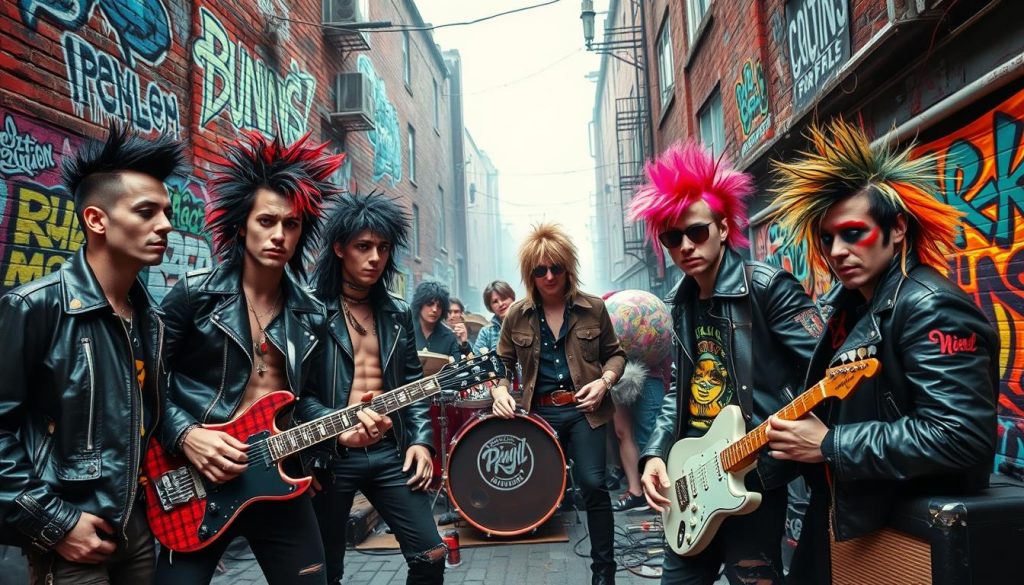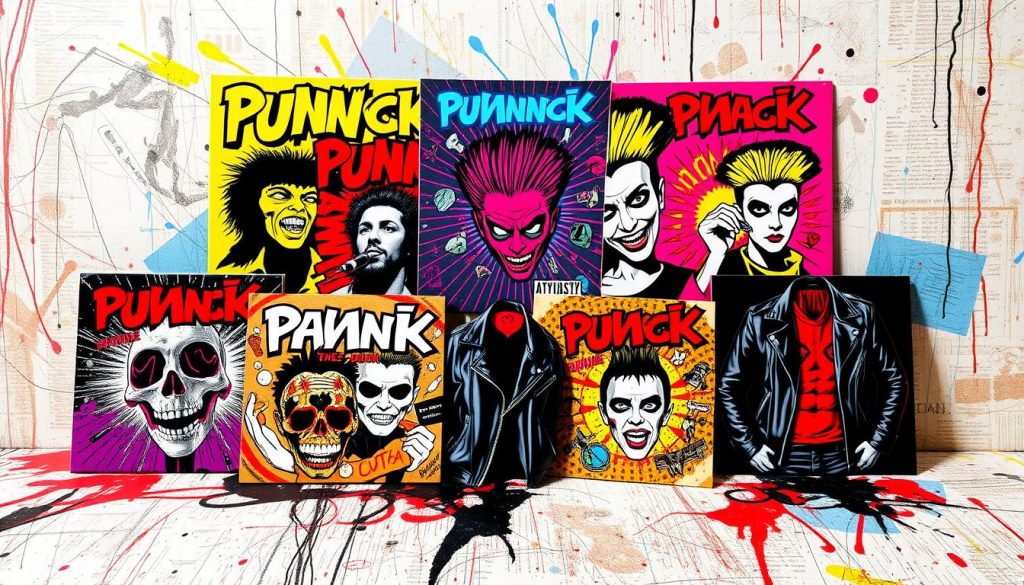The Punk Rock Scene of the 1980s
The punk rock scene of the 1980s was more than just music. It was a cultural movement filled with rebellion and individuality.
Anúncios
It started in the late 1970s and brought a new wave of punk bands to the scene. These bands spoke to the youth, urging them to challenge mainstream norms.
This era was all about raw emotion and true expression. It greatly influenced the 1980s music scene and beyond.
Legendary bands like The Ramones, Sex Pistols, and The Clash were at the forefront. They used their music to express defiance and social critique. The punk fashion was just as bold, becoming a symbol of the movement.
As punk rock grew, it branched out into different styles. Hardcore punk and pop-punk emerged, each making a lasting impact on music.
Anúncios
Introduction to the Punk Rock Scene
The punk rock movement burst onto the scene in the 1980s. It was known for its raw and aggressive sound. This sound was a big change from traditional music.
It started because people were unhappy with society. This movement spoke to a generation wanting to change things. Punk rock was about being independent, expressing yourself, and rebelling against rules.
This culture was all about doing things yourself. Fans and musicians worked together to make and share music. The punk rock look was bold, with ripped clothes, bright hair, and tattoos.
This look showed the punk rock values. It was a way to express yourself and stand out.
Punk rock mixed music with messages about society. It gave a voice to those who felt trapped. Bands like this inspired others to speak out and create change.
These bands helped pave the way for future artists. They made sure punk rock’s spirit could grow and change.
Origins of Punk Rock in the 1980s
Punk rock started in the late 1970s. It was a time of discontent with mainstream music and big social issues. Artists like The Velvet Underground and The Stooges were key. They inspired the punk movement with their rebellious and raw sound.
In the 1980s, punk rock evolved a lot. Bands started playing faster and with more intense lyrics. The American hardcore punk scene grew, attracting fans who wanted a deeper connection with music. Underground venues became key places for new bands to emerge and shape the genre.
Punk rock’s influence went beyond music. It changed fashion, art, and how people saw society. It brought fans together, sharing a love for rebellion. This movement also sparked talks about freedom and changing social norms.
| Key Element | Description |
|---|---|
| Musical Influences | Artists like The Velvet Underground and The Stooges shaped early punk sounds. |
| Tempo and Lyrics | Faster tempos and raw, aggressive lyrics became hallmarks of the genre. |
| Underground Venues | Local clubs and DIY spaces facilitated the rise of various punk bands. |
| Cultural Impact | Punk rock influenced fashion, art, and societal attitudes towards authority. |
Influential Bands of the 1980s Punk Rock Scene
The 1980s punk rock scene saw the rise of several influential punk bands. The Clash is one of the most celebrated punk rock icons. They were known for their powerful political lyrics and innovative fusion of various musical styles.
Other notable 1980s punk groups included Black Flag, famous for their raw sound and aggressive approach. They pushed boundaries and explored darker themes in their music. Dead Kennedys became known for their satirical and incisive commentary on sociopolitical issues. Bad Religion contributed a melodic yet confrontational style to the mix, solidifying their role as one of the key players in the landscape of punk rock during this era.
These influential punk bands collectively established a rich tapestry of sounds and messages. Their contributions had a lasting impact on both the punk rock genre and the broader music culture. For more insights about these iconic groups, explore this detailed overview of punk rock.

Punk Rock Culture and Its Impact on Society
Punk rock culture has deeply influenced society, changing music, fashion, and social views. Punk fashion, with its leather jackets and bright hair, stands for self-expression and rebellion. This style has made its way into everyday clothes, becoming a part of mainstream fashion.
Punk rock’s impact goes beyond just looks. It speaks to those who feel left out by society. Punk music’s messages push people to question authority and fight for their rights. This genre has sparked many social movements, bringing together people with similar views.
Punk rock has shaped young people’s identities. It emerged during tough economic times and political unrest. Punk rock gave a voice to frustration and anger, inspiring people to be themselves and resist following the crowd.
- Influence on Fashion: Punk fashion remains iconic, with elements like spiked accessories and graphic tees becoming staples in wardrobes.
- Community Building: Punk culture created inclusive spaces for individuals to connect over shared values and interests.
- Political Activism: Many punk bands, such as Dead Kennedys and Anti-Flag, often address political issues, inspiring listeners to take action.
The punk rock culture’s impact is still seen today. It drives conversations about identity, freedom of expression, and social justice.
Music Festivals and Punk Rock Events
The 1980s were a lively time for punk rock festivals. These events helped spread punk’s influence far and wide. The Warped Tour, for example, became a key spot for live punk music events. It let fans see both famous and new bands perform live.
These gatherings brought people together, creating a community around punk culture. It was a time when fans could connect over their love for punk music.
The Punk Rock Bowling festival in Las Vegas was another big hit. It featured punk concerts 1980s and was all about fun and friendship. Fans enjoyed the music and took part in activities that celebrated the punk lifestyle.
These events were crucial in shaping punk’s history. They gave bands a chance to shine and connect with their fans.
Many punk rock festivals have made a lasting impact. They brought together fans and artists in a special way. This environment encouraged creativity and teamwork.
Festivals often mixed different music styles. This showed the variety within punk rock and its subcultures.
| Festival Name | Location | Year Established | Notable Bands |
|---|---|---|---|
| Warped Tour | U.S. Nationwide | 1995 | Blink-182, Green Day, NOFX |
| Punk Rock Bowling | Las Vegas, NV | 1999 | Rancid, Descendents, Lagwagon |
| Rebellion Festival | Blackpool, UK | 1996 | The Damned, UK Subs, Cock Sparrer |
These festivals celebrated live punk music events. They showed punk rock’s strength and ability to change with the times. They were key for fans and bands to connect, keeping punk rock alive and kicking.
Iconic Punk Rock Albums from the 1980s
The 1980s were a key time for punk rock music. Many 1980s punk albums came out, shaping the genre. “London Calling” by The Clash is famous for its mix of sounds and deep lyrics. It talked about social and political issues.
“Damaged” by Black Flag is another big album. It had raw energy and dealt with identity and struggles. These albums are essential punk music that still affects listeners today.
These albums have had a big impact on punk and mainstream music. They are known for their unique guitar riffs and strong messages. Here are some of the most iconic albums of the decade:
| Album | Artist | Year Released | Key Themes |
|---|---|---|---|
| London Calling | The Clash | 1979 | Social injustice, political unrest |
| Damaged | Black Flag | 1981 | Identity, struggle, rebellion |
| Screaming for Vengeance | Judas Priest | 1982 | Defiance, empowerment |
| Fresh Fruits for Rotting Vegetables | Dead Kennedys | 1980 | Satire, corruption |
| Pleasure Island | The Dickies | 1982 | Satire, pop culture |
Listening to these classic punk records shows the 1980s punk scene’s spirit. Their energetic sound and messages helped pave the way for future punk bands. They are a big part of music history.

The Global Reach of Punk Rock Culture
Punk culture has grown into a rich mix, shaped by local issues and social dynamics. The first punk wave in the US in the late 1970s set the stage for punk’s global influence. Countries like the UK and Australia created their own punk scenes, adding their cultural stories to the genre.
In the UK, punk spoke out against political and economic troubles. Australian bands added humor and irony. Brazil saw a burst of creativity, with bands tackling social injustices and political corruption through their music.
- UK: Explored issues of class struggle and socio-political unrest.
- Australia: Introduced humor, irony, and a distinct local identity.
- Brazil: Focused on social injustice and political oppression.
Punk movements worldwide have brought people together. Punk’s spirit of rebellion unites those who want to challenge the status quo. As punk culture grows globally, it continues to inspire new generations to express themselves and seek change.
Legacy of the 1980s Punk Rock Scene
The 1980s punk rock scene left a lasting mark on music and culture. It brought a raw, honest way of expressing oneself. This approach broke down barriers in the arts and culture.
Today, musicians still draw from this punk ethos. They create music in genres like alternative rock and hip-hop. This shows the lasting impact of the 1980s punk rock scene.
Many artists today look to the 1980s punk rock scene for inspiration. Bands like Green Day and Blink-182 capture the energy and rebellious spirit of punk. They honor the punk sound while sharing their own messages.
Punk culture is alive and well today. It has influenced mainstream art, fashion, and lifestyle. Festivals and events celebrate this legacy, connecting fans with punk’s roots and new interpretations.
The punk scene’s visual motifs and attitudes promote a DIY philosophy. Many artists and creators embrace this idea. It encourages them to be independent and creative.
| Influence | Modern Manifestations |
|---|---|
| Raw Sound | Grunge, Emo |
| Rebellion | Activism, Street Art |
| Aesthetic | Fashion Trends, Multimedia Art |
| DIY Ethos | Independent Labels, Home Studios |
The punk rock legacy continues to shape cultural discussions today. It inspires artists and fans to challenge norms and express themselves. Through music and shared values, punk culture remains a powerful force in creativity worldwide.
Conclusion
The punk rock scene of the 1980s was a key force. It changed the music world and stood up against the norms. Bands like The Ramones, Sex Pistols, and Dead Kennedys made a big impact. They influenced not just punk but all music, breaking rules and changing how artists connect with fans.
Punk rock culture was also very important. It was a movement that celebrated being different and questioning the status quo. With its unique mix of music, fashion, and ideas, punk rock left a lasting mark on the 1980s. It inspired many musicians and fans, shaping the music scene forever.
The punk rock scene of the 1980s still influences us today. It reminds us of the era’s energy and honesty. Looking back, it’s clear punk rock’s impact is still felt. It continues to call for freedom of expression and change, a message that will always be relevant.
